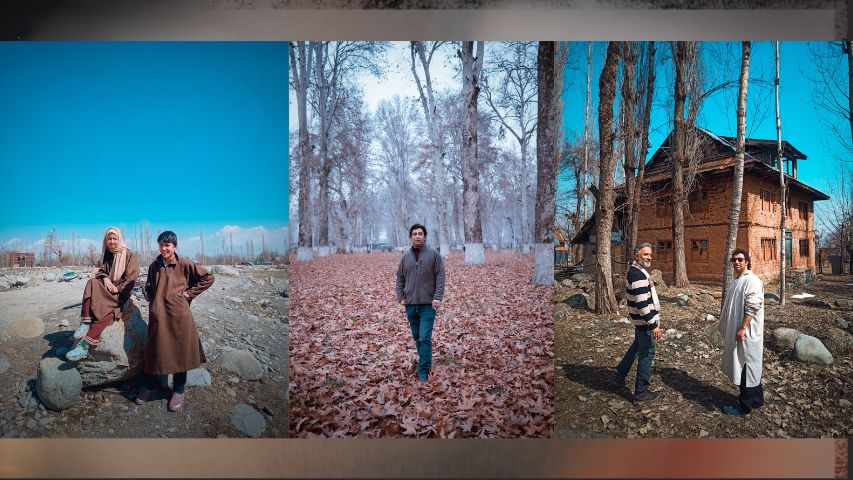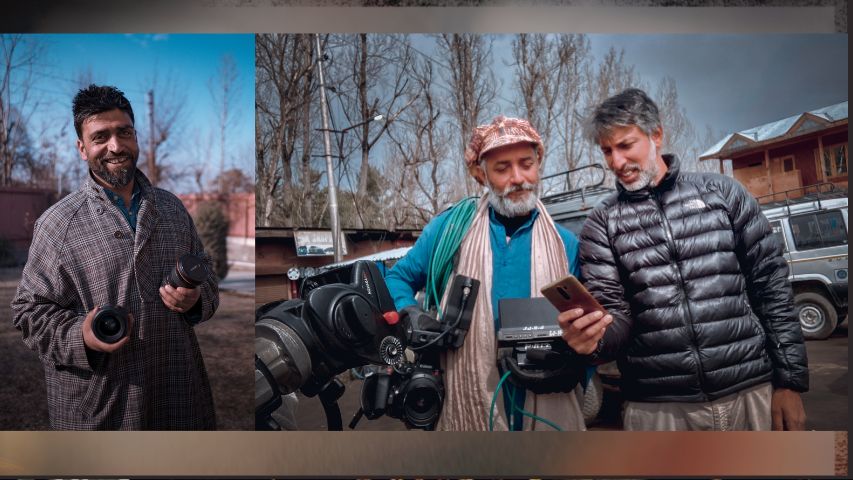-853X543.jpg)
INDEPENDENT FILM: THE STORY OF A YOUNG BOY IN KASHMIR
by Vinta Nanda January 18 2024, 12:00 am Estimated Reading Time: 9 mins, 1 secIn conflict-ravaged Kashmir, Adnan, a young boy from a lower middle-class family, stretches himself beyond limits to earn a smile on his blind sister’s face by buying her a birthday cake, writes Vinta Nanda.
Kasheer Kaete is a glimpse into the arduous life of an ordinary young boy, Adnan, for whom a seemingly simple task of acquiring a birthday cake for his sister turns out to be a difficult task. His efforts, however, are left at the mercy of circumstance when while returning from the town bakery, Adnan’s bicycle chain breaks and causes unexpected delay. The army checkpoint on his way home is on high alert that night because of an apparent security concern. The guard is trained to show utmost vigilance in dealing with passers-by, even children who have been occasionally deployed by insurgents to carry explosives. The contextual and circumstantial realities of both their worlds collide as Adnan faces intense scrutiny and questioning by the guard, and has to pass through the barrel of the gun while his sister awaits the birthday cake with hope.
Writer-director, Arif Bashir, draws inspiration largely from his personal experiences of growing up in Kashmir. A writer, poet, and communications postgraduate who hails from a small village located in Northern Kashmir’s Tangmarg area, he grew up seeing conflict up close and deeply affecting his friends and family. In his debut film he attempts to document the real and the imaginary, the harsh and the subtle, the substantial as well as nuanced realities of Kashmir, all seen through the eyes and lived experiences of a child.
With an eye for detail, sensitivity toward humanitarian issues, and without falling into the trap of propaganda, Arif Bashir's film presents his homeland as a place in search of peace. Setting his film in his native village where he lives has added an emotional as well as nostalgic angle in its making.
On being asked what compelled him to make Kasheer Kaete, he said, “While several large scale films are made on the Kashmir conflict, few have attempted to explore the psychological impact of conflict on children. We wanted to highlight the tense situation for both a young boy and an army man, both victims of their own circumstantial realities, who come face to face with a situation beyond their control”.
He says that suffering in silence, as victims of an externally-driven conflict, civilians are burdened with the simple struggles of earning a livelihood, maintaining a home, addressing the needs of a family and, sometimes, even daring to dream. “Conflict poses interruptions even on the simplest of aspirations”.
Sukant Panigrahi (Production Designer) and Viraj Singh (Cinematographer), the producers of the film, are award-winning artists and lifelong friends. Their long standing dream to make films has finally come to fruition by way of their production house Gifted Images. As established technicians in the industry, they collaborated successfully with several directors around the world. Over the course of their travels, they encountered fascinating people and places. Gifted Images came to become a reality in Kashier Kaitey, for which Sukant and Viraj brought their respective crafts to collaborate with Arif Bashir.
When I connected with Viraj Singh, and told him that I want to write a piece on their film, he was gracious. He said, “My friend Sukant and I were dreaming of starting out our own venture to make films in a certain way that we enjoy. I was actually just talking about this with my friend earlier today, that the way a film is made dictates a lot about it. After all it’s the same camera, lights, actors and locations that every filmmaker uses, but magically everyone emerges with different things. I think it’s the process of making the film that has a large part to play in the outcome. We can talk about that when we speak, but this is our first step into this new world”.
And, we did speak, over many days of back and forth, on Whatsapp and email. And, I’ll turn over to the conversation with no further delay.

Where did your journey as a cinematographer start and then bring you this point?
I’ve been working for the last 23 years. I am an undergraduate from the University of Washington, in Seattle. As students, we got a one year work visa post college. It was after college that I realised this was something I wanted to do. It kind of came to a point, at the end of college, where I realised I needed to decide on a career.
During college I had worked as a journalist, event planner, marketer, and done a few other jobs, and it was journalism that I liked the most. Through that I was able to take the first step of learning the camera. Not having been to film school, I started learning on my own.
These were the years prior to YouTube so it was through books, shooting my own projects and apprenticing, which I did for 7 years. I landed up working for one of the top DOPs in the country, Mr. Ravi K Chandran. Post that I got a Charles Wallace fellowship, where I got to work in London for 6 months. It was a very exciting time. Then I started my career as a DOP, working in the industry, doing ads, documentaries and movies.
However as a DOP, one only works on the projects offered, a sentiment both Sukant and I shared. We had worked on so many, some together as well. He harboured a desire to be a director. He put his own money into multiple projects over the years. I suppose it came from a shared love of doing something together that we believed in, and doing it in ways we wanted to.
Tell me a bit about your collaborations with Sukant Panigrahi and Arif Bashir? How did all of you meet?
Arif and Sukant met on a film shooting in Delhi. Sukant was the production designer, and Arif was working on the script with the director of the project. Later, Sukant worked on a Hindi film in Kashmir, for which Arif was the local fixer, helping with locations and other things. I met Arif when he visited Mumbai. Sukant brought him over to my house, and we had a wonderful conversation. My love for Kashmir traces back many years. I am fortunate to have had great experiences of travelling and shooting in the Valley at the time I was an assistant. And since the last 11 years, I have fallen in love with snowboarding, and thus visited Gulmarg every year.
What is the film Kasheer Kaete about? And, what compelled the three of you to make it?
During the lockdown, I went to Kashmir a few times to make music videos. During the making of the first one, having come to Kashmir after a long time, I decided to spend some time with Arif. He is an amazing storyteller, and it was great to be with him in Srinagar. He narrated many stories of his childhood, his life, and about things and events to me.
Arif is a sensitive person, who has deep knowledge especially about Kashmir. One of his stories was that of Adnan, and it became Kasheer Kaete. It is a true story coming from his own experiences while growing up in a village. During our time together, we visited his village and I realized what a beautiful place it was.
Tanmarg is on the way to Gulmarg. It’s a place we usually pass by without giving it a second glance. There are general stores, and car garages on the main road, but I realised after this little adventure with Arif, that once you turn off the main road there’s a village where time stands still. So, I told Arif that his story will work well if we shoot it in this village, because it is where he has grown up.
As young professionals and entrepreneurs in the business of entertainment, what are your thoughts about Kashmir and the problems there?
As everyone would say, it is a complex issue that dates back too many years. The Kashmiris are, from my experience, beautiful, loving, and polite people. It’s unfortunate that they belong to a place, which has seen so many ups and downs because of both external reasons and internal rumblings. Kashmir is one of the most beautiful parts of the world, ironically the most conflicted and militarised as well.
In addition to the travels, snowboarding, hiking and cultural experiences, I find it fascinating from a filmmaking and storytelling point of view. Any character you place in Kashmir has a lot to deal with emotionally, socially and politically. The complexities there give the stories added layers.

You have spent a lot of time in the valley. What are your thoughts and observations about the future of the people living there?
As someone who is interested in culture and people, Kashmir is an endless place to explore. What is going to happen is very open to a number of factors, which are not in anybody’s control. There are so many players affecting the outcome of what happens. However, for me, the process of getting to make films, and explore the region through this medium, is my way of exploring and understanding the complexities.
What keeps taking you to Kashmir?
The people, their culture, their food and land. I love the way the people look, how the landscape changes with every season. Also, I am a big fan of snowboarding, and it is the best place in the country for that.
What are your plans for Kasheer Kaete?
My plan is to follow the journey of taking it to festivals, and see how far our story can reach. It is my first effort in making a film that I personally believe in. I’ve put my own money and time into making it.
Anything else you'd like to share about the film, the journey that the three of you have taken and what all of you plan to do next?
The idea that we were trying to explore in the film was about perspectives. We have tried to show that both the boy and the soldier are acting upon what the circumstances have made permissible.
We didn’t want to show the soldier in a bad light because he is also a victim of the failure of the system. When people watch our film they will see how difficult life is for ‘ordinary’ people on both sides of the fence.




-173X130.jpg)
-173X130.jpg)
-173X130.jpg)
-173X130.jpg)
-173X130.jpg)
-173X130.jpg)
-173X130.jpg)
-173X130.jpg)